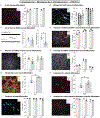A reference human induced pluripotent stem cell line for large-scale collaborative studies
- PMID: 36459969
- PMCID: PMC9782786
- DOI: 10.1016/j.stem.2022.11.004
A reference human induced pluripotent stem cell line for large-scale collaborative studies
Abstract
Human induced pluripotent stem cell (iPSC) lines are a powerful tool for studying development and disease, but the considerable phenotypic variation between lines makes it challenging to replicate key findings and integrate data across research groups. To address this issue, we sub-cloned candidate human iPSC lines and deeply characterized their genetic properties using whole genome sequencing, their genomic stability upon CRISPR-Cas9-based gene editing, and their phenotypic properties including differentiation to commonly used cell types. These studies identified KOLF2.1J as an all-around well-performing iPSC line. We then shared KOLF2.1J with groups around the world who tested its performance in head-to-head comparisons with their own preferred iPSC lines across a diverse range of differentiation protocols and functional assays. On the strength of these findings, we have made KOLF2.1J and its gene-edited derivative clones readily accessible to promote the standardization required for large-scale collaborative science in the stem cell field.
Keywords: CRISPR; differentiation; iPSC; karyotype; p53; pluripotent; reference; single-cell; stem cell; whole-genome.
Published by Elsevier Inc.
Conflict of interest statement
Declaration of interests S.W.S. is on the scientific advisory council of the Lewy Body Dementia Association and the MSA Coalition. S.W.S. is an editorial board member for the Journal of Parkinson Disease and JAMA Neurology. S.W.S. received research support from Cerevel Therapeutics. M.K. serves on the scientific advisory boards of Engine Biosciences, Casma Therapeutics, Cajal Neuroscience, and Alector and is a consultant to Modulo Bio and Recursion Therapeutics. Participation by researchers from Data Tecnica International, LLC in this project was part of a competitive contract awarded to Data Tecnica International, LLC by the National Institutes of Health to support open science research. M.A.N. also currently serves on the scientific advisory board for Clover Therapeutics and is an advisor to Neuron23 Inc. E.A. is founder, shareholder, and scientific advisor of Cholestenix, Ltd.
Figures






References
-
- Kwart D, Gregg A, Scheckel C, Murphy EA, Paquet D, Duffield M, Fak J, Olsen O, Darnell RB, and Tessier-Lavigne M (2019). A Large Panel of Isogenic APP and PSEN1 Mutant Human iPSC Neurons Reveals Shared Endosomal Abnormalities Mediated by APP beta-CTFs, Not Abeta. Neuron 104, 256–270 e255. 10.1016/j.neuron.2019.07.010. - DOI - PubMed
-
- Konttinen H, Cabral-da-Silva MEC, Ohtonen S, Wojciechowski S, Shakirzyanova A, Caligola S, Giugno R, Ishchenko Y, Hernandez D, Fazaludeen MF, et al. (2019). PSEN1DeltaE9, APPswe, and APOE4 Confer Disparate Phenotypes in Human iPSC-Derived Microglia. Stem Cell Reports 13, 669–683. 10.1016/j.stemcr.2019.08.004. - DOI - PMC - PubMed
-
- Guttikonda SR, Sikkema L, Tchieu J, Saurat N, Walsh RM, Harschnitz O, Ciceri G, Sneeboer M, Mazutis L, Setty M, et al. (2021). Fully defined human pluripotent stem cell-derived microglia and tri-culture system model C3 production in Alzheimer’s disease. Nat Neurosci 24, 343–354. 10.1038/s41593-020-00796-z. - DOI - PMC - PubMed
Publication types
MeSH terms
Grants and funding
- MR/R015724/1/MRC_/Medical Research Council/United Kingdom
- T32 AG000255/AG/NIA NIH HHS/United States
- R01 NS027036/NS/NINDS NIH HHS/United States
- R01 NS060698/NS/NINDS NIH HHS/United States
- T32 NS115706/NS/NINDS NIH HHS/United States
- RF1 AG072052/AG/NIA NIH HHS/United States
- WT_/Wellcome Trust/United Kingdom
- R01 AG072052/AG/NIA NIH HHS/United States
- F32 NS114319/NS/NINDS NIH HHS/United States
- R01 NS117461/NS/NINDS NIH HHS/United States
- ZIA AG000535/ImNIH/Intramural NIH HHS/United States
- R01 GM127557/GM/NIGMS NIH HHS/United States
- R01 DK125747/DK/NIDDK NIH HHS/United States
- T32 AG066596/AG/NIA NIH HHS/United States
LinkOut - more resources
Full Text Sources
Other Literature Sources
Research Materials
Miscellaneous

